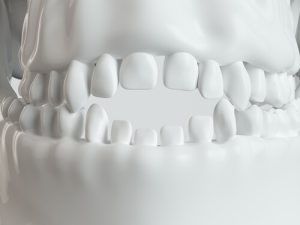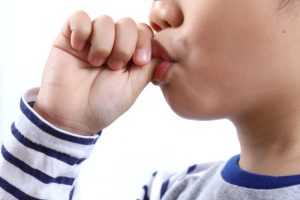
Contents
- 1 Understanding Thumbsucking: Causes and Common Age Range
- 2 Direct Impact: How Thumbsucking Affects Dental Alignment
- 3 Long-Term Dental Issues Associated with Prolonged Thumbsucking
- 4 Recognizing the Signs: When Thumbsucking Becomes a Concern
- 5 Preventive Strategies and Techniques to Discourage Thumbsucking
- 6 Professional Interventions: When to Seek Help from a Dentist or Orthodontist
- 7 References
The damage to teeth from thumbsucking is a concern for many parents, as this seemingly innocent habit can have lasting impacts on a child’s oral development. While it’s natural for infants and young children to find comfort in thumbsucking, prolonged dependence can lead to significant dental issues, including misaligned teeth and bite problems.
But how does this habit alter a child’s thumb and dental structure, and how can it be mitigated before lasting damage occurs? Delve into the dynamics of thumbsucking and discover preventive measures to protect your child’s dental health.
Understanding Thumbsucking: Causes and Common Age Range

Thumbsucking is a natural reflex for children, often beginning in the womb and continuing through early childhood. This habit provides comfort and security, helping children manage anxiety or fall asleep more easily. For many infants, thumbsucking is essential to self-soothing during their first years of life.
Detailed Overview of Thumbsucking:
- Natural Reflex: Thumbsucking starts as a natural reflex observed even in the womb. This behavior is primarily for self-soothing and comfort, particularly in infants and toddlers.
- Age Range: It is most common in children from infancy to 4 years old. As children grow older and explore the world more actively, the habit typically decreases and eventually stops.
- Psychological Comfort: For many children, thumbsucking is a way to deal with anxiety or discomfort. It provides security in stressful situations or helps them transition to sleep.
- Potential Issues: While generally harmless in babies and toddlers, thumbsucking can become problematic if it continues once a child’s permanent teeth emerge. Persistent thumbsucking during this stage can lead to misaligned teeth, particularly affecting the front teeth, and can alter the proper growth of the mouth and jaw.
- Dental Impact: Prolonged thumbsucking can lead to an open bite, where the upper and lower teeth do not meet when the mouth is closed, or cause the upper teeth to protrude outward, which might require orthodontic treatment later in life.
Direct Impact: How Thumbsucking Affects Dental Alignment
Thumbsucking, especially when prolonged, can significantly impact a child’s dental alignment, leading to various orthodontic issues that may require intervention. This habit exerts pressure on the teeth, the upper jaw, and the roof of the mouth, influencing how they develop and align.
Detailed Impact of Thumbsucking on Dental Alignment:
- Alteration of Jaw Shape: The constant pressure from thumbsucking can affect the natural growth of the jawbones, leading to altered jaw development. For children who suck vigorously, this can result in more pronounced changes.
- Development of Open Bite: One of the most common dental issues associated with thumbsucking is the development of an open bite. This occurs when the upper and lower front teeth do not touch when the mouth closes, creating a noticeable gap.
- Protrusion of Upper Teeth: Extended thumbsucking can cause the upper front teeth to tilt outward. This affects a child’s bite and their ability to close their mouth fully, sometimes impacting speech and eating.
- Misalignment of Permanent Teeth: If the habit continues beyond the eruption of permanent teeth, it can lead to misaligned teeth that might require orthodontic treatment, such as braces or clear aligners, to correct.
- Impact on Speech: Altered dental structures can also affect a child’s speech patterns, potentially leading to speech impediments that might require therapy.
Long-Term Dental Issues Associated with Prolonged Thumbsucking

Prolonged thumbsucking can lead to several long-term dental issues that may extend beyond childhood, impacting the aesthetics and functionality of a child’s mouth. Parents must be aware of these potential complications to take timely preventive actions.
Detailed Overview of Long-Term Dental Issues from Prolonged Thumbsucking:
- Malocclusion: Continuous thumbsucking can result in various forms of malocclusion, where the alignment of the teeth and the way the upper and lower teeth fit together are affected. Common forms include open bite, where the front teeth don’t touch when the mouth is closed, and overbite, where the upper teeth protrude significantly over the lower teeth.
- Altered Palate: The pressure exerted by the thumb in the mouth can also deform the hard palate, leading to a high, narrow arch. This alteration can complicate issues with the bite and may require orthodontic correction.
- Tooth Misalignment: As the permanent teeth grow, their alignment can be significantly affected by the continued presence of a thumb in the mouth. This may lead to crooked teeth or teeth that are positioned unusually, which often require braces or other corrective orthodontic treatments.
- Gum Recession: Thumbsucking can cause excessive pressure on the gums, potentially leading to gum recession over time. This condition exposes more of the tooth’s root, increasing sensitivity and susceptibility to cavities or other dental problems.
- Speech Impediments: Altered dental structures due to thumbsucking can affect a child’s ability to pronounce words correctly, leading to potential speech impediments such as lisping or difficulty articulating certain sounds.
Recognizing the Signs: When Thumbsucking Becomes a Concern

Thumbsucking is a normal part of development for many children, but it can become a concern if it persists as they grow older, particularly as permanent teeth emerge. Recognizing the signs that indicate when thumbsucking has become problematic is crucial for preventing long-term dental issues.
Signs That Thumbsucking Has Become a Concern:
Age of the Child: Thumbsucking typically diminishes and stops by the age of four. If a child continues to suck their thumb beyond this age, especially after the age of five or six when permanent teeth start to appear, it may lead to dental complications.
Changes in Teeth Alignment: Noticeable changes in how the child’s teeth align, such as the front teeth protruding outward from the mouth or not meeting when the mouth is closed, are clear indicators. These misalignments can become permanent if thumbsucking continues.
Alterations in Jaw Structure: If the child’s jaw appears to be misshaped or if there is an obvious alteration in the roof of the mouth (palate), which might become more arched or sensitive, these are signs that thumbsucking is affecting normal oral development.
Complaints of Mouth Problems: Pay attention if the child complains about pain in the jaw, difficulty biting, or discomfort in the mouth, as these could be signs of issues caused by persistent thumbsucking.
Calluses on the Thumb: A callus on the thumb the child sucks is a physical sign that thumbsucking is frequent and intense. This can indicate that the habit is ingrained and may be difficult to break without intervention.
Social and Emotional Impact: If thumbsucking impacts the child’s social interactions or faces teasing from peers, it might also be time to address the habit for emotional and dental health reasons.
Preventive Strategies and Techniques to Discourage Thumbsucking

Preventing or discouraging thumbsucking in children is crucial, especially if the thumb-sucking habit persists past the age when it is developmentally appropriate. Here are several strategies and techniques that can help manage and eventually eliminate thumbsucking:
Preventive Strategies and Techniques:
Positive Reinforcement: Reward the child for not sucking their thumb. Use a reward chart to track progress and offer small rewards for extended periods without sucking, such as stickers or a favorite activity.
Identify Triggers: Understand when and why the child tends to suck their thumb. Often, children engage in thumbsucking when feeling insecure or needing comfort. Addressing the underlying cause—anxiety, fatigue, or boredom—can help reduce the behavior.
Offer Alternatives: Provide other means of comfort or distraction, especially during times when the child is likely to suck their thumb. This could be a soft toy, a blanket, or even engaging the child in a hands-on activity to keep their hands busy.
Use Gentle Reminders: Instead of scolding, gently remind the child of their goal to stop thumbsucking when you see them engaging in the habit. Some parents use a bandage on the thumb or a sock on the hand at night as a reminder.
Educate About the Consequences: Depending on the child’s age, explaining the effects of thumbsucking on their teeth and how it can lead to dental visits might motivate them to stop. Use age-appropriate language to ensure they understand.
Create a Comforting Bedtime Routine: Since thumbsucking is often used as a self-soothing technique, creating a calming bedtime routine can reduce the child’s need to suck their thumb to fall asleep.
Consult a Pediatric Dentist: If home strategies are ineffective, a pediatric dentist can offer additional interventions such as mouth appliances that physically prevent thumbsucking or safe, bitter-tasting coatings that can be applied to the thumb.
Professional Interventions: When to Seek Help from a Dentist or Orthodontist

While many children naturally outgrow thumbsucking, professional intervention may be necessary when the habit of thumbs up persists beyond the typical age and begins to affect dental and oral development. Knowing when to seek help from a dentist or orthodontist can ensure timely and effective treatment to prevent long-term issues.
When to Seek Professional Help:
- Persistent Thumbsucking Beyond Age Four: If a child continues to suck their thumb after their permanent teeth start to come in, typically around age five or six, it’s advisable to consult a dental professional. Continued thumbsucking during this stage can lead to significant dental misalignments.
- Noticeable Dental Problems: If you observe changes in the alignment of the child’s teeth or alterations in the roof of their mouth or jaw structure, these are signs that the thumbsucking is impacting their oral development. An open bite, protrusion of the upper front teeth, or a crossbite are common issues.
- Difficulty in Breaking the Habit: When efforts to stop the thumbsucking at home have been unsuccessful, especially as the child approaches school age, seeking professional advice can provide additional strategies and support.
Professional Interventions Available:
- Dental or Orthodontic Appliances: Dentists or orthodontists can prescribe oral appliances that fit within the mouth and physically prevent thumbsucking. These devices are typically non-painful and serve as a gentle reminder not to suck the thumb.
- Customized Mouth Guards: Similar to appliances, custom mouthguards can cover the upper arch of the teeth, making thumbsucking less satisfying and more difficult.
- Behavioral Techniques: Professionals can also recommend specific behavioral methods tailored to the child’s age and emotional needs, which can be more effective than generalized advice.
- Parental Guidance and Support: Dentists and orthodontists can also provide crucial guidance to parents on how to help their child break the habit.
Addressing the damage to baby teeth from thumbsucking early is crucial for safeguarding your child’s oral health. By recognizing the signs and implementing effective strategies to curtail this habit, parents can prevent long-term dental issues and promote healthier dental development. If you notice persistent thumbsucking beyond the preschool years, consulting with a dental professional can provide targeted interventions to correct any alignment problems and ensure your child’s beautiful, healthy smile.
References
How Does Thumb Sucking Affect the Teeth?
https://www.healthline.com/health/parenting/thumb-sucking-teeth
Thumb Sucking: How Does it Impact Your Teeth?
https://www.webmd.com/oral-health/what-to-know-thumb-sucking-impact-teeth
Damaging Oral Habits – PMC
https://www.ncbi.nlm.nih.gov/pmc/articles/PMC4409805/
Thumb Sucking | Johns Hopkins Medicine
https://www.hopkinsmedicine.org/health/conditions-and-diseases/thumb-sucking
Impact of Pacifiers & Thumb Sucking on Children’s Teeth
https://aaoinfo.org/whats-trending/can-pacifiers-and-thumb-sucking-affect-my-childs-teeth/



